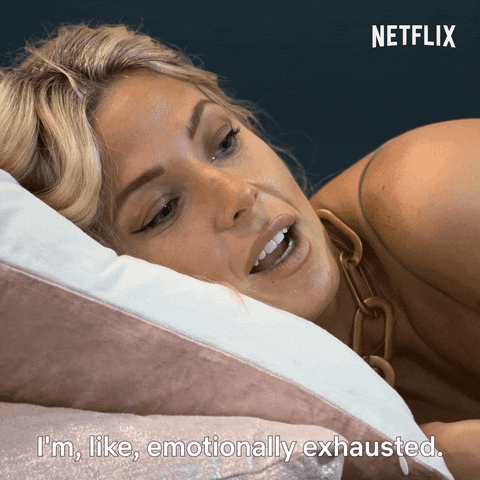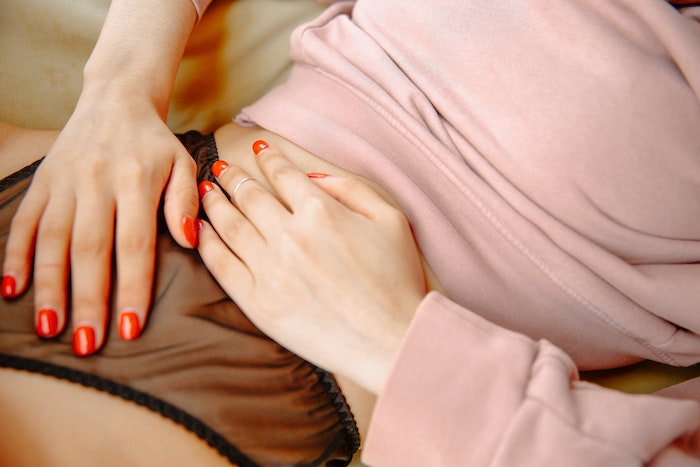Many of us experience some sort of “crash” after indulging too much in a good thing. Binging on carbohydrate or sugar-rich food and drinks often abruptly leads to tiredness or sleepiness. Too much alcohol gives us the dreaded hangover in the morning after.
In the kink community, particularly in BDSM, crashes are referred to as “drops”. An intense play session typically coincides with immense pleasure caused by several factors working together. When all is said and done, the drop rears its ugly head.

The submissive (sub) or bottom of the relationship is usually the one who falls victim to drops. For the most part, the experience is like getting pummeled by a smorgasbord of negative physical and emotional side effects simultaneously.
If left unchecked, “sub drops” may lead to serious, long-lasting, or even permanent damage. Understanding where they come from and knowing the appropriate preventive and curative measures are vital to ensuring the overall welfare of the submissive in case they get the drop.
The Subspace

Drops and crashes always have a point of origin. In the case of sub drops, it’s the subspace (sub space or sub-space) more often than not.
The subspace is a trance-like state that’s described as euphoric or being at the peak of sexual pleasure. It draws significant comparison to disassociation, but with the main difference being that the subspace is, by and large, a positive rush.
The subspace experience is different from person to person. Some say it’s like being pleasantly intoxicated (drunk or high) and incoherent. Other submissives report getting an out-of-body experience, hence the presumed correlation to disassociation.
The science behind the subspace is rather limited. But certain studies theorize that hormones have a lot to do with it. Endorphins—the quintessential “feel-good” hormone—gush through the body together with the stress hormones, such as adrenaline, cortisol, and so on. This causes an imbalance in the blood’s chemical makeup, resulting in a barrage of side effects that eventually lead to the subspace.

S&M (sadism and masochism) kink plays are excellent examples of a subspace trigger. An intense session prompts the increased production of naturally occurring chemicals to counteract pain and discomfort. Reaching the subspace is one of the primary reasons why many BDSM practitioners engage in consensual sadomasochistic acts.
Each submissive has an individual set of requirements for reaching this exquisite state. Flogging and deprivation may do it for Carl but not for Angel, who gets the push from breath play and bondage.
Note that some people never experience subspace despite partaking in particularly stirring kinks. Not all submissives require getting into the subspace for full BDSM enjoyment. Some adamantly aim for it but others consider it merely as a lovely bonus and not reaching it is not a deal-breaker.
As with most parts of BDSM, entering the subspace has its risks. Its numbing effect might drive the submissive to ask or even demand more punishment and pain beyond their body’s threshold. It falls on all involved parties to recognize this serious safety concern before the scene.
What is a Sub Drop?
A sub drop is when the submissive leaves the subspace as a result of the waning down of all those buzzy hormones. When this happens, the person experiences a physiological and emotional low. It is very much a “Too much ‘haha!’ pretty soon ‘boohoo!’” sort of situation.

Physical exhaustion is the most common and immediately noticeable symptom. A general feeling of unwellness envelops the sub, much like having the flu or a particularly vindictive hangover. Other physical manifestations of sub drop include:
- Unstable heart rate and blood pressure
- Extreme body temperatures
- Dizziness and nausea
- Gastrointestinal pain or discomfort
- Excessive sweating
- Muscle stiffness, pain, or cramps
- Blurred vision
- Sleepiness
- Hunger and thirst
These come on top of the expected and practical aftereffects of the acts performed in the scene, such as pain and soreness from impact play, for instance.

For many subs, the emotional and mental toll of experiencing sub drop is what hurts the most. It’s generally described as a concentrated bout of depression. In more specific terms, examples of the non-physical effects of sub drop are:
- Irritability and hostility
- Volatile mood swings
- Sadness, which may lead to crying
- Guilt, shame, and anxiety
- Confusion and incoherence
- Difficulty in communicating
- Fear and anger
- Becoming anti-social
- Depersonalization—the feeling of being detached from one’s body
Sub drops vary from person to person. One play session may yield a different combination of the above-mentioned physical, emotional, and mental consequences from the next.
Some submissives get “drip-fed” by their sub drop. In this case, they don’t get the dramatic influx of symptoms that leave them feeling emotionally raw. Days after a scene, they feel “normal” and in control but certain triggers, like minor inconveniences, for example, will send them into a fit of panic. That’s when they realize that they’re still within the drop zone.
It’s worth noting that there are subs who don’t get drops. Experience has little to do with whether or not a person will get it. For the most part, it’s all a matter of chance.
Sub Drops: When and How Long After a Play Session
Quantifying when the sub drop occurs after kink plays is far from simple. One person may report getting yanked out of the subspace immediately after a session has concluded. That same person may say the drop hit them a few hours or two days later on different occasions.
At times, one may feel like they lucked out since they didn’t get the drop. But actually, there’s still a large surplus of hormones careening through their body. The receptors that detect these natural chemicals haven’t gotten to dealing with them just yet. Therefore, they’ve yet to feel the side effects.
When the body finally comes around to sorting the imbalance, that’s the time when delayed sub drops happen. This setback may take hours to even weeks from when an intense scene has wrapped up—surprising submissives who thought they came out of a session unscathed.

The way and time it takes for subspace hormones to leave the body is largely dependent on the person’s physical condition—how quickly their body metabolizes hormones—at the time when the scene has ended. The same goes for how long the body recovers from the chemical imbalance caused by the subspace. The submissive’s emotional and mental constitutions also contribute to the latter.
The body also has a way of screwing itself over when metabolizing excess hormones. Sometimes it will produce another chemical that tells itself to stop producing an offending hormone. It might overproduce the second one, so in order to counteract that surplus, it will produce a third hormone and so on.
If this happens, the body will then have another cocktail of hormones that is, in a way, no longer explicitly related to the subspace and the intense BDSM scene.
It’s like having pasta with not enough sauce on it. We put on more sauce but end up adding more than needed. So we add more pasta but then we overcompensate again. It goes on until we have a mountain of food on a plate with the wrong pasta-to-sauce ratio.
This almost comical cycle is one of the major causes of prolonged recovery periods from sub drops.
Dealing With Sub Drop After an Intense Session
In most cases, immediate relief from sub drop is achieved by practicing proper aftercare—a set of restorative actions geared toward minimizing the harsh effects of a scene.
If a sub gets the drop right after a session, they have the benefit of having their Dominant around to administer aftercare measures, which largely depend on specific symptoms as well as the sub’s particular wants. A good Dom who genuinely cares for their submissive would come into the scene prepared.

In any case, BDSM partners must always have a drop kit or aftercare kit on hand before starting scenes. A standard aftercare kit may include the following:
- First-aid kit and manual for injuries
- Energy-giving snacks and beverages
- Items for relaxation, such as bath salts, essential oils, etc.
- Communication devices in case of emergencies
- Books, board games, and other distracting activities
- Movie and TV show DVDs
BDSM partners must also take into account submissive-specific aftercare procedures. Providing what the sub considers as comfort food instead of generic replenishment is a good example. Essentially, this means giving them anything that will make them feel better if at all possible.
But there will come points when a sub has to perform self-care. This can happen for several reasons, including but not limited to:
- If the sub refuses to interact with the Dom for whatever reason
- If the Dom is incompetent and doesn’t know the first thing about aftercare
- If the sub experiences delayed sub drop and there’s a long distance between them and their Dom
- If the sub wants alone time
It’s a common misconception that a submissive absolutely needs companionship when dealing with sub drops. Many submissives are more than capable of successfully tackling sub drops on their own. Here is a short checklist of what a sub can do in terms of solo aftercare.
1. Self patch-up

A sub may feel disconnected from reality instantly after a session and may resent any physical attention from another person. This takes the Dom out of the equation when it comes to treating injuries brought on by the scene.
The sub must know to immediately perform first-aid on themself as needed. They must clean and dress broken skin and any injuries that drew or are drawing blood.
This is easier said than done, especially when pain-inhibiting hormones still flood their system. But a quick visual run-through of the body should do the trick.
2. Identifying emotions

Knowing is half the battle. It will be easier for a sub to address emotional detriment if they can pinpoint and identify each one accurately. BDSM newbies might have a harder time of it because some of the emotions they feel during a sub drop are new to them. With time, this becomes easier.
It wouldn’t hurt to write down and describe what and how they feel in great detail. Crafting countermeasures for each negative emotion becomes more guided and deliberate. For instance, if the sub is able to pin down guilt, they can formulate an effective resolution that will ease the feeling the next time they experience it.
A majority of the emotions that subs feel during a drop are irrational. It wouldn’t be surprising if a submissive starts denying these feelings out of shame. But they’ll be doing themself a disservice if they do so. They must acknowledge that unreasonable behaviors and emotions are part and parcel of hormonal imbalance and that they’re virtually out of their control.
3. Meditation

Meditation is a simple yet powerful tool for combating stress and purging the mind of the bad mojo that came from an intense session. It brings a person closer to the present—away from the effects of sub drop. It also wards off feelings of self-scrutiny.
Breathing exercises during meditation also relax muscles and joints, which is beneficial for physical recovery.
By its nature, meditation is not a very involved activity. Finding beginner-friendly video tutorials online is incredibly easy. There are also free mobile apps for various types of meditation.
4. Remembering important people

Just the knowledge that there are people who deeply care for them can massively help a person make it out of tough situations. Gathering emotional support this way lessens the pressure to interact while still getting a healthy dose of healing.
Knowing that they have friends and family, their Dom included, who are just a phone call away when they need them can help a submissive pare down the effects of post-scene depression and loneliness. It’s a figurative warm blanket, which imparts a significant feeling of security and assurance.
5. It’s all temporary

A sub who has accepted that sub drops are an inherent part of kink play has a better chance of shaking off their effects successfully. Holding on to positive feelings before the drop sets in makes it easier for a submissive to reel themself out from the void.
The sub drop must always be seen as a passing phase that, unpleasant as it is, has no lasting power over a person. It’s a product of a pleasurable experience. And people who want to relive that enriching feeling must be ready to deal with sub drops over and over again.
Are Sub Drops Preventable?
Preventing sub drop is somewhat possible. Though the unpredictability of the body’s responses to the scene does make it a bit tricky to completely ward it off.
Pre-gaming with a light but nutrient-rich meal at least an hour before the scene will prepare the body for the oncoming energy expenditure. This means high-protein, low-carb, and lots of veggies. The body will also use this meal as an immediate stockpile of recovery nutrients at the end of the session.

Making sure that one is in an excellent mood before a scene will also temper the effects of sub drops. Going into a scene already stressed or exhausted will only aggravate the possible side effects. Taking a rain check until moods are in optimal conditions would not be a bad idea.
As with doing any hard-hitting physical activity, stretching goes a long way. A bit of cardio will get the blood flowing loosely and improve stamina as well.
Wrapping Up
Sub drop is normal. It’s a natural reaction to consensual kink plays and no one should be faulted for it. A couple can make the most out of experiencing and dealing with sub drops by learning from them and devising healthy ways of minimizing their post-play impact.
With enough awareness, preparation, and communication, play partners can vastly improve their handling of sub drops and reclaim some precious post-scene time for themselves.
Doms provide proper submissive aftercare and a whole lot more. Start your journey to true dominance with our detailed primer.





